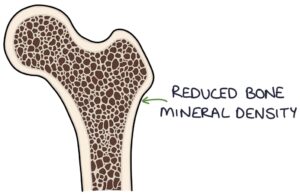Osteoporosis involves a significant reduction in bone density. Osteopenia refers to a less severe decrease in bone density. Reduced bone density makes the bones weaker and prone to fractures.

The World Health Organization (WHO) provide definitions based on the T-score of the femoral neck, measured on a DEXA scan. The T-score is the number of standard deviations the patient is from an average healthy young adult. A T-score of -1 means the bone mineral density is 1 standard deviation below the average for healthy young adults.
|
Diagnosis |
T Score at the Hip |
|
Normal |
More than -1 |
|
Osteopenia |
-1 to -2.5 |
|
Osteoporosis |
Less than -2.5 |
|
Severe Osteoporosis |
Less than -2.5 plus a fracture |
Bone Mineral Density
Bone mineral density (BMD) is measured using a DEXA scan (dual-energy x-ray absorptiometry). DEXA scans are a type of x-ray that measures how much radiation is absorbed by the bones, indicating how dense the bone is. The bone mineral density can be measured anywhere on the skeleton, but the femoral neck reading is most important.
Bone density can be represented as a Z-score or T-score. The Z-score is the number of standard deviations the patient is from the average for their age, sex and ethnicity. The T-score is the number of standard deviations the patient is from an average healthy young adult. The T-score is used to make the diagnosis.
Risk Factors
- Older age
- Post-menopausal women
- Reduced mobility and activity
- Low BMI (under 19 kg/m2)
- Low calcium or vitamin D intake
- Alcohol and smoking
- Personal or family history of fractures
- Chronic diseases (e.g., chronic kidney disease, hyperthyroidism and rheumatoid arthritis)
- Long-term corticosteroids (e.g., 7.5mg or more of prednisolone daily for longer than 3 months)
- Certain medications (e.g., SSRIs, PPIs, anti-epileptics and anti-oestrogens)
TOM TIP: Post-menopausal women are an important group where osteoporosis should be considered. Oestrogen is protective against osteoporosis but drops significantly after menopause. Hormone replacement therapy (HRT) is protective against osteoporosis. Tamoxifen is a selective oestrogen receptor modulator (SERM) used to treat breast cancer. It blocks oestrogen receptors in breast tissue but stimulates oestrogen receptors in the uterus and bones. It helps prevent osteoporosis but increases the risk of endometrial cancer. Raloxifene is a SERM used to treat osteoporosis (but not breast cancer in the UK).
Assessment
The NICE clinical knowledge summaries (April 2023) recommend assessing:
- Anyone on long-term oral corticosteroids or with a previous fragility fracture
- Anyone 50 and over with risk factors
- All women 65 and over
- All men 75 and over
The 10-year risk of a major osteoporotic fracture and a hip fracture can be calculated using either:
- QFracture tool (preferred by NICE)
- FRAX tool (NICE say this may underestimate the risk in some patients)
Patients are categorised as low, intermediate or high risk based on the risk calculator. For QFracture, this is based on the percentage, and patients above 10% are considered for a DEXA scan. For FRAX, this is based on the NOGG guideline chart (linked to on the online FRAX tool), which advises whether to arrange a DEXA scan or start treatment.
These suggestions do not apply to specific groups. For example, NICE CKS (April 2023) suggest:
- A DEXA may be arranged without calculating the risk in patients over 50 with a fragility fracture
- Treatment may be started without a DEXA in patients with a vertebral fracture
Management
The first step is to address reversible risk factors. For example, increase physical activity, maintain a healthy weight, stop smoking and reduce alcohol consumption.
The second step is to address insufficient intake of calcium (less than 700mg per day) and inadequate vitamin D (e.g., limited sun exposure) with additional:
- Calcium (at least 1000mg)
- Vitamin D (400-800 IU)
Bisphosphonates are the first-line treatment for osteoporosis. They are recommended for patients with osteoporosis based on a DEXA scan. They are considered in patients on long-term steroids. They work by interfering with the way osteoclasts attach to bone, reducing their activity and the reabsorption of bone.
Bisphosphonates have some important side effects:
- Reflux and oesophageal erosions
- Atypical fractures (e.g., atypical femoral fractures)
- Osteonecrosis of the jaw (regular dental checkups are recommended before and during treatment)
- Osteonecrosis of the external auditory canal
Oral bisphosphonates are taken on an empty stomach with a full glass of water. Afterwards, the patient should sit upright for 30 minutes before moving or eating to reduce the risk of reflux and oesophageal erosions.
Examples of bisphosphonates are:
- Alendronate 70 mg once weekly (oral)
- Risedronate 35 mg once weekly (oral)
- Zoledronic acid 5 mg once yearly (intravenous)
The NICE CKS (2023) recommend reassessing treatment with bisphosphonates after 3-5 years. They suggest a repeat DEXA scan and stopping treatment if the T-score is more than -2.5. Treatment is continued in high-risk patients.
Other specialist options for treating osteoporosis (where bisphosphonates are not suitable) include:
- Denosumab (a monoclonal antibody that targets osteoclasts)
- Romosozumab (a monoclonal antibody that targets sclerostin – a protein in osteocytes that inhibits bone formation)
- Teriparatide (acts as parathyroid hormone)
- Hormone replacement therapy (particularly in women with early menopause)
- Raloxifene (a selective oestrogen receptor modulator)
- Strontium ranelate (a similar element to calcium that stimulates osteoblasts and blocks osteoclasts)
Strontium ranelate increases the risk of venous thromboembolism and myocardial infarction.
Raloxifene stimulates oestrogen receptors in the bone but not in the uterus or breast. It increases the risk of venous thromboembolism.
Last updated September 2023
